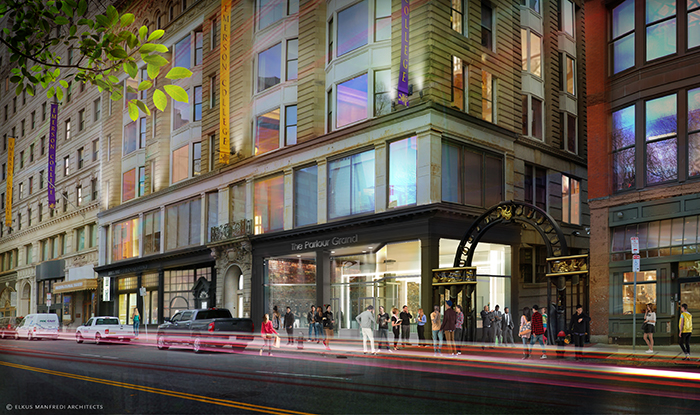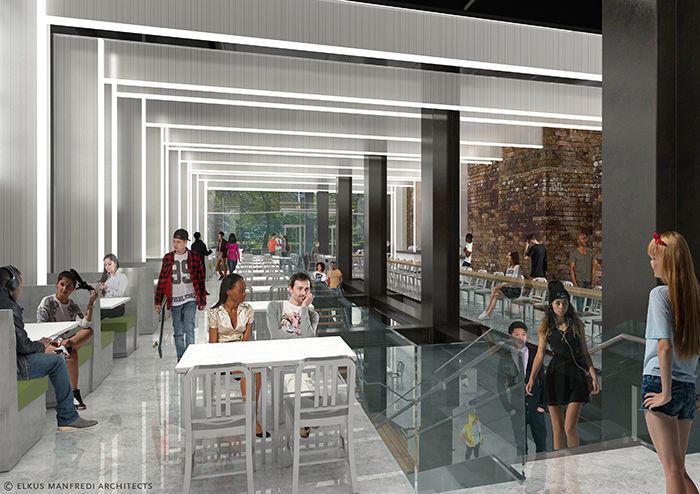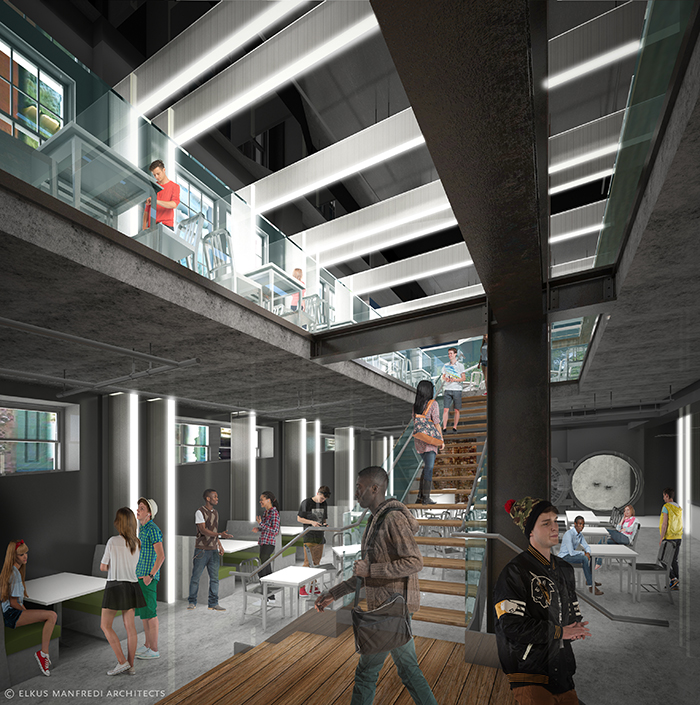Emerson to Create Student Dining Center
In an email message to the Emerson community, President Lee Pelton shared today that the Board of Trustees, upon the recommendation of an ad hoc task force previously announced (November 2015), unanimously approved a plan to restore and renovate 122-124 Boylston Street and 19 Boylston Place to create a permanent student dining facility and expanded social spaces that will be completed before the beginning of the fall of 2017.
“The renovated and redesigned facility will have an exciting programmatic connection to 2 Boylston Place, the eighteen-story residence hall that is scheduled to open concurrently with this new facility,” Pelton wrote.
Designed by Elkus Manfredi, the architectural firm that has brilliantly restored many of Emerson’s downtown facilities including the Paramount Center and Cutler Majestic Theatre, the Student Dining Center will be on two above ground elevations that can be entered either from Boylston Street or from 19 Boylston Place adjacent to the Walker Building.

Architect’s renderings show that the two elevations within the Student Dining Center will be connected by a grand, open staircase. There will be seating on both elevations, with additional warm weather outside seating that will complement the outside seating at the 2 Boylston Place student residence hall. The kitchens and service stations will be on the lower elevation. And there is potential for private dining rooms and small social areas that may be reserved for meals, meetings, or other campus events as well as a small stage in the lower level for students to use for evening and late night café style performances and rehearsals.
The new Dining Center will be more than 18,000 square feet and provide seating for 550—a significant increase in capacity compared to Emerson’s current main dining hall located in the Little Building, which is approximately 12,500 square feet and seats 297.
All of the properties being used for this project were acquired by Emerson College during the mid- to late-1990s, such that the College will not need to purchase or make investments in real estate it does not own.
The creation of this exciting new facility, at the juncture of Boylston Street and Boylston Place will strengthen the College’s identity and establish the location as the center and the main portal to the urban campus. When completed, this area will be newly animated and vibrant in ways that will benefit not only Emerson College, but the city and citizens of Boston. Adding to the vibrancy of this section of Boylston Street, is Emerson’s recently opened Visitor Center, which receives thousands of prospective students and their families each year.

“As was well reported in the media, as the College studied various options for replacing the dining hall in the Little Building, which is scheduled to be closed May 2017–August 2019 for extensive renovation, consideration was given, among other options, to incorporating dining facilities potentially into the redesign of the Colonial Theatre as multi-use theatre space,” wrote Pelton.
“However, the ad hoc task force has concluded that the Boylston Street/Boylston Place project is a superior option for student dining because it expands the College’s square footage for dining and social space, it provides architectural and programmatic connectivity to 2 Boylston Place and it creates a ‘front porch,’ a sense of place and enhanced identity for the College on Boylston Street,” he continued.
“The College continues to be engaged in a parallel effort that has been underway for several months to assess the Colonial Theatre programming options for its future. I appreciate and remain touched by the interest that the performing arts communities and some of our faculty demonstrated in their commitment to the Colonial. We value the theater’s history and its beauty. We have a team of people working hard on studying the options for its continued use as a theater space,” Pelton wrote.
“I am very grateful to Boston Mayor Marty Walsh and his team, including Joyce Linehan, Julie Burros, and John Barros, for their ongoing support and consultation,” he continued.

Pelton, who chaired the ad hoc task force initiative, thanked the ad hoc task force members that helped guide the Board’s deliberations with respect to its three-prong charge to:
a. Evaluate and develop programming partnerships, lease, and other arrangements related to reanimating the Theatre;
b. Identify, analyze, and price repairs and renovations to the Colonial physical plant; and
c. Analyze and evaluate options related to Emerson student dining, social space, and retail space along the Boylston Street corridor.
Jeff Greenhawt, chairman of the Board of Trustees
Steve Samuels, trustee
Robert Friend, trustee
Richard Janssen, trustee
Linda Schwartz, trustee
Marillyn Zacharis, trustee
Catherine Peterson, overseer, and executive director, Arts Boston
Melia Bensussen, chair, Performing Arts Department
Jabari Asim, Board of Trustees faculty representative, associate professor, Writing, Literature & Publishing
Emily Solomon, ’17, Board of Trustees student representative, President, Student Government Association
David Dower, vice president, Office of the Arts, and executive director, ArtsEmerson
Maureen Murphy, vice president for Administration and Finance
Margaret Ings, associate vice president for Government and Community Relations
Anne Shaughnessy, director, Office of the President and executive assistant, Board of Trustees
The ad hoc task force continues to meet to identify programming partnerships, lease options, and other arrangements for the Colonial as well as identify, analyze, and price repairs and renovations to the Colonial physical plant, whose findings the ad hoc task force will report to the Board of Trustees in due course.
Pelton said that he looks forward to sharing more news with the community regarding the ongoing work of the ad hoc task force when more progress has been made.
In his message to the Emerson community, Pelton noted that plans for enhancing the Boston campus began taking shape as long as three years ago.
He wrote: “Our explorations were informed and influenced by several considerations with an eye towards creating a campus that would:
- Have a logical and welcoming front door with the historic Boston Common as its frame of reference;
- Create a vibrant commonwealth of learning and living with additional social spaces, housing for more of our students and more robust, exciting dining options;
- Include classroom, rehearsal, studio and production facilities befitting our aspiration to be the global hub for higher learning in communication, the arts and liberal arts; and
- Be mindful of Emerson’s sense of place in an urban, downtown core setting.”
“There has been much to consider and we have carefully sifted through multiple, complex configurations. As I have written earlier, our thinking has been principally guided by place-making, in particular to strengthen the identity of the College by animating the streetscape along Boylston Street and across from the Boston Common that would inspire, embrace and celebrate our great City’s emerging diversity,” Pelton wrote.
Categories